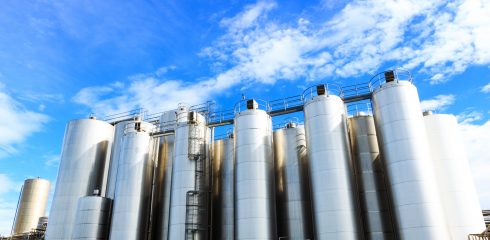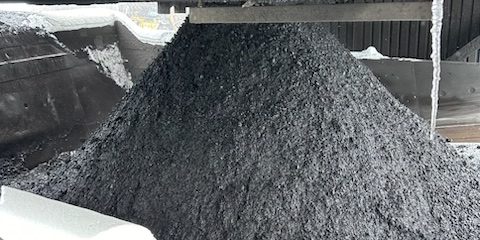
Powders and bulk solids often present handling challenges that cannot be solved with equipment alone. Some flow easily while others plug, segregate, or degrade during processing. These behaviors are rooted in the properties of the particles themselves. From size and shape to moisture sensitivity, particle characteristics determine how materials behave in motion, in storage, and in contact with handling systems. Without a detailed understanding of these characteristics, even well-designed material handling systems can fail to perform reliably.
Particle Size and Size Distribution
The size of individual particles plays a defining role in how materials move and mix. It influences not just flow behavior but also how particles separate, settle, or disperse into the air.
- Fine particles can become suspended in air currents, increasing dust hazards, causing equipment fouling, and complicating pneumatic transport. Or they can stick together and form masses or agglomerates plugging bins and hoppers. They can also have rate limitations due to air interaction during discharge.
- Coarse particles flow more freely but strike surfaces with more force, bringing about mechanical wear, noise, and the degradation of contact components.
- Particles with wide size distributions often segregate in hoppers, conveyors, or silos. This can result in inconsistent blending and erratic dosing performance.
Such characteristics influence whether a material can be fed, mixed, or conveyed consistently in material handling systems. Inadequate sizing information may cause flow stoppages or over-designed systems that waste energy and space.
Particle Shape
Shape determines how particles orient, compact, and resist motion. Thus, it becomes a vital driver of bulk flow and material handling behavior.
- Spherical particles roll and slide efficiently through equipment, reducing friction and promoting consistent movement through hoppers and chutes.
- Angular or irregular particles tend to interlock, increasing resistance to flow, which often establishes bridging, erratic feed rates, and hopper blockages.
- Flake-like or fibrous particles may layer, align, or entangle during movement, obstructing flow paths and complicating metering accuracy.
Each of these shape-driven behaviors directly influence flow resistance and particle alignment within hoppers and chutes. When neglected, they can lead to blockages and frequent manual intervention.
Bulk Density
Bulk density impacts how materials are stored, moved, and metered, influencing both equipment sizing and structural design.
- Low-density materials occupy more volume per unit mass, resulting in underfeeding in volumetric systems and the inefficient use of storage space.
- High-density materials impose higher loads on mechanical material handling systems and structures, increasing the need for reinforced equipment and more energy-intensive transport.
Accurate bulk density measurements help match material volume to material handling equipment capacity. Misjudging density causes feed errors, overloading, and compromised structural integrity across handling systems.
Moisture Content and Hygroscopicity
Moisture influences flow characteristics, stability, and the way materials interact with their material handling environment.
- Materials with high moisture levels tend to clump or form sticky masses, contributing to blockages in hoppers and loss of control in dosing systems.
- Materials with hygroscopicity absorb ambient humidity, changing texture and flow behavior, and may degrade chemically during storage or transport.
Consistent environmental control is essential to ensure stable flow when dealing with moisture-sensitive powders. Without it, clumping, microbial contamination, and unplanned downtime become persistent operational challenges.
Flowability
Flowability reflects how easily a bulk solid moves under gravity or force and underpins nearly every stage of material handling.
- Free-flowing materials move predictably through hoppers and feeders, enabling stable operations and accurate metering.
- Poorly flowing materials require mechanical aids and often stop moving altogether, causing ratholing, arching, or inconsistent feed rates.
Reliable flow is central to efficient handling system performance. A mismatch between material behavior and material handling equipment design often facilitates flow interruptions and erratic discharge rates.
Cohesion and Adhesion
Cohesive and adhesive forces influence how particles bind to each other and interact with equipment surfaces.
- Cohesive materials tend to stick together under pressure, forming clumps or bridges that prevent discharge and disrupt flow regulation.
- Adhesive powders attach to chute walls, mixers, and feeders, leading to buildup, contamination, and prolonged cleaning cycles.
Flow irregularities and material handling equipment fouling often originate from cohesive and adhesive behaviors. These forces reduce discharge reliability, complicate cleaning procedures, and increase the likelihood of inconsistent feed rates, especially in finely tuned production environments.
Compressibility and Permeability
Compressibility and permeability govern how materials settle and how gases move through a bulk solid.
- Compressible materials settle unevenly in hoppers or feeders, causing flow disruption and fluctuating discharge rates.
- Low-permeability powders restrict airflow, complicating aeration or pneumatic transport, and often require higher pressure or modified system geometry.
Airflow resistance and material compaction in material handling are often driven by these characteristics. If not accounted for, they can disrupt discharge consistency, impair pneumatic transport, and force corrective redesigns downstream.
Reactivity and Toxicity
Hazardous materials introduce strict requirements for containment, operator safety, and environmental compliance.
- Reactive materials may ignite, degrade, or emit gases under normal conditions, necessitating sealed systems and inert atmospheres.
- Toxic powders require closed transfer systems, advanced filtration, and robust personal protective equipment to minimize exposure risks.
Processes handling dangerous substances must ensure consistent isolation, control, and monitoring. These demands influence every material handling design decision, from equipment seals to process automation.
Translating Particle Properties into System Success
Every reliable material handling process begins with a comprehensive knowledge of particle behavior. At Jenike & Johanson, we specialize in identifying and measuring these properties through advanced particle testing services. This insight helps our clients anticipate flow challenges and design systems that deliver consistent, efficient, and safe performance. Speak with our experts to discover how particle testing can unlock the full potential of your material handling operations.





